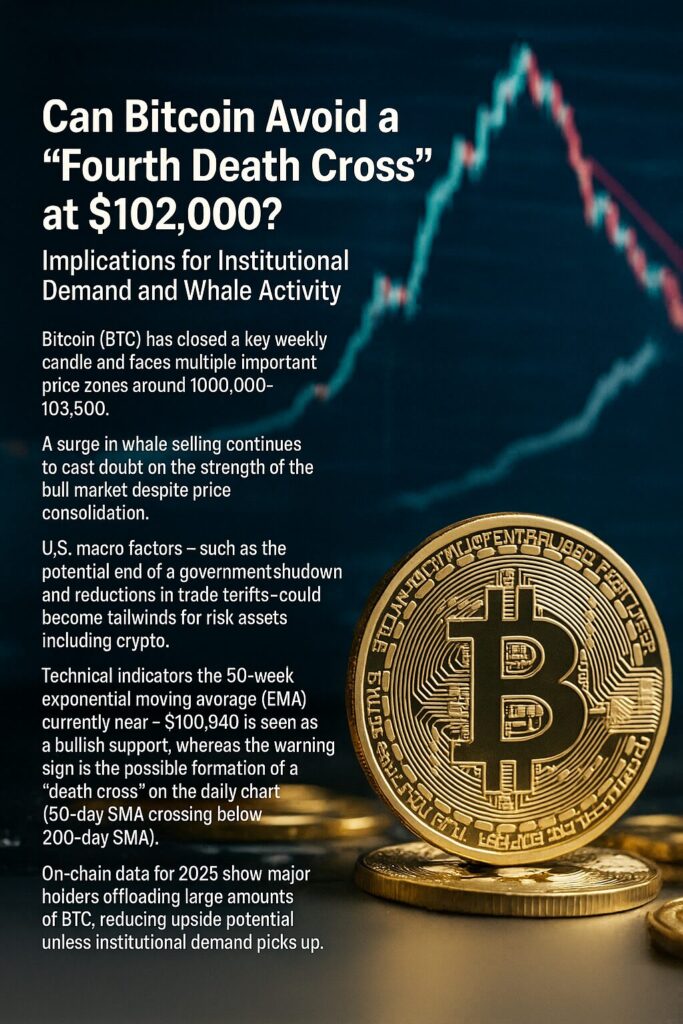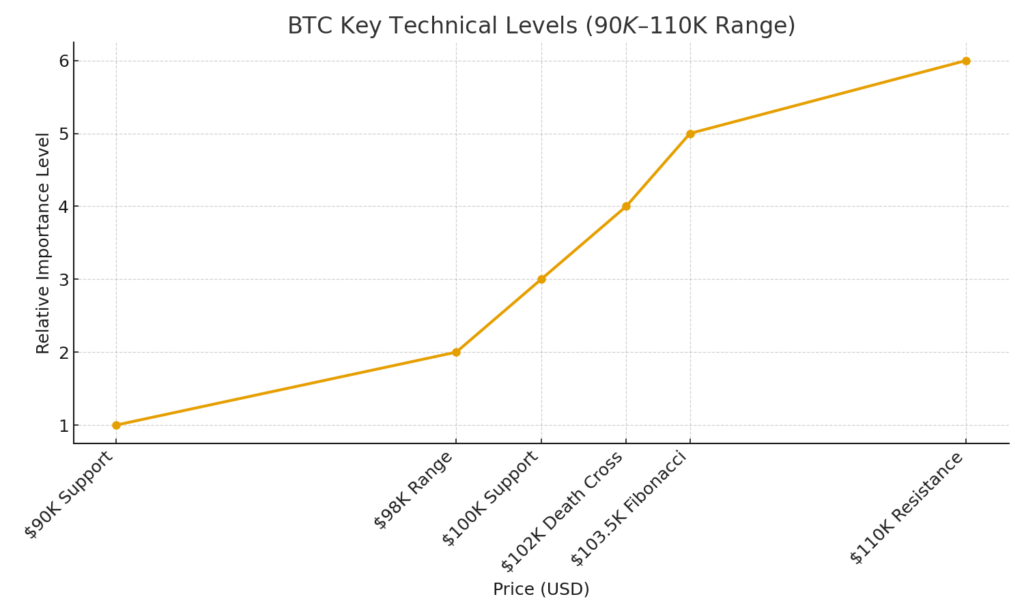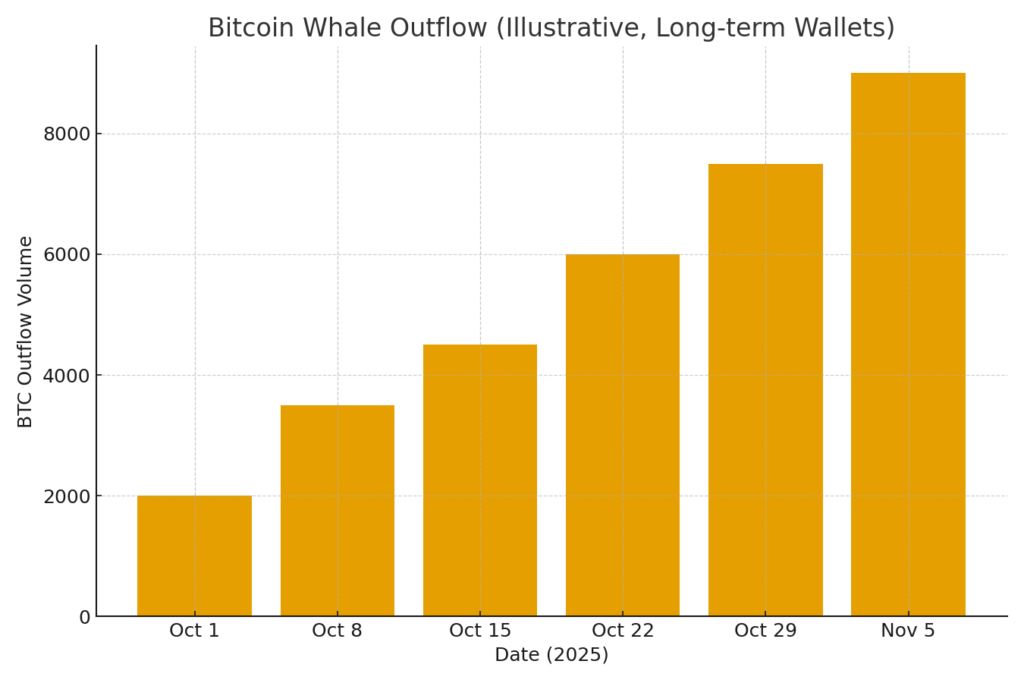
Main Points :
- Bitcoin (BTC) has closed a key weekly candle and faces multiple important price zones around $100,000–$103,500.
- A surge in whale selling continues to cast doubt on the strength of the bull market despite price consolidation.
- U.S. macro factors—such as the potential end of a government shutdown and reductions in trade tariffs—could become tailwinds for risk assets including crypto.
- Technical indicators: the 50-week exponential moving average (EMA) currently near ~$100,940 is seen as a bullish support, whereas the warning sign is the possible formation of a “death cross” on the daily chart (50-day SMA crossing below 200-day SMA).
- On-chain data for 2025 show major holders offloading large amounts of BTC, reducing upside potential unless institutional demand picks up.
1. Weekly Close and Key Price Levels
Bitcoin has held above the psychologically and technically important $100,000 mark, yet has traded in a tight range as the market awaits the weekly candle close. According to data from Cointelegraph Markets Pro and TradingView, volatility has been muted over the weekend, signalling indecision.
A noted trader, Titan of Crypto, tweeted that the key level this week is $103,500, based on Fibonacci retracements. He cautioned that while a breach below this level doesn’t require immediate pessimism, a clear break in the next week could signal the end of the bullish cycle.
Meanwhile, other market participants point to the 50-week EMA (currently near ~$100,940) as a bullish threshold—closing above it would reinforce the uptrend, while closing below would raise risk of a deeper correction.
Thus, for investors seeking new crypto assets or blockchain-related yield opportunities, the next few days are critical: a hold above support suggests consolidation and accumulation, whereas a breakdown could imply risk of a more meaningful pullback.
*(Insert weekly BTC-USD chart here: “Figure 1: BTC/USDT weekly chart – key levels $100k, $103.5k, 50-week EMA”) *
2. The Threat of a “Fourth Death Cross” on the Daily Chart

Beyond the weekly picture, technical watchers are focused on the potential formation of a so-called “death cross” on the daily chart of Bitcoin. A death cross occurs when a short-term moving average (such as the 50-day SMA) crosses below a longer-term moving average (such as the 200-day SMA), traditionally signalling trend weakness.
Trader SuperBro has remarked that this would be the fourth death cross in the current bull cycle and that historically these have led to either mean-reversion to the average or sustained base formation. He noted that near the 365-day SMA, reactions have been weak so far, and bullishs will be watching whether the weekly close can reclaim the Q3 low.
It is worth emphasising, however, that death crosses are lagging indicators—they often confirm a trend that is already underway rather than forecasting a new one. As noted by several sources, their historical reliability as a standalone sell signal is limited.
For practical purposes—especially for those exploring new altcoin opportunities or yield generation in the blockchain space—the message is: if Bitcoin remains above key supports and avoids the cross, then risk-on may persist; if the cross occurs and breaks key support, rotation to alternative assets or deeper consolidation may ensue.
*(Insert daily BTC-USD chart here: “Figure 2: BTC/USDT daily chart – 50-day and 200-day SMA and death cross risk”) *
3. Whale Activity and Supply Pressure

Beyond technicals, the on-chain data paint a picture of uneven demand and supply dynamics. According to recent reporting, whales (addresses holding more than 10,000 BTC) have been consistent net sellers over the last three months, while smaller-scale holders (below 1,000 BTC) continue accumulating.
Another source reports that “OG” whales — long-term holders with coins unmoved for 7+ years — have sold more than 1 million BTC since June, via outflows in the $100 million-$500 million range.
This divergence suggests that while retail and smaller holders may be stacking, large holder pressure is suppressing upward breakout. For those hunting new crypto assets or looking for yield via staking, this means caution: the broader market may lack the strong institutional flow needed for a sustained breakout, and instead may remain range-bound or risk correction.
Macro risk factors are further complicating the picture. For example, one article notes that long-term holders are gradually decreasing, funding rates are weak, and Bitcoin is trading below the 200-day MA—raising concerns of a liquidity crunch entering the end of the four-year cycle.
The key takeaway: the supply side is proving heavier than many hoped, and only a shift in demand dynamics (especially institutional) is likely to alter the equilibrium.
*(Insert chart showing whale outflows and holder cohorts here: “Figure 3: On-chain flows – large holder net selling vs smaller holder accumulation”) *
4. Macro Landscape: Trade Tariffs, Government Shutdown and Risk Assets
Turning to macro considerations, the article highlights two specific tailwinds that could benefit risk assets including crypto: (1) the potential resolution of the U.S. government shutdown, and (2) reduction in U.S. trade tariffs.
The notion is that if the U.S. Congress resolves the shutdown and global trade tariff burdens ease (e.g., via a ruling by the U.S. Supreme Court invalidating certain tariffs), this could reinvigorate equities and other risk assets—and by extension crypto. In one contribution, Kas Abbe suggests that such developments could mark the end of the “manipulation” phase for Bitcoin and the start of an expansionary regime.
However, more cautious participants (for instance, Ted Pillows) warn that if the market’s expectations for government resolution are disappointed, then institutional demand may falter and Bitcoin may slip further from ~$102,000 levels.
For readers focused on practical blockchain applications or emerging crypto assets, this suggests that while the crypto market may benefit from improved macro sentiment, the timing and magnitude are uncertain. It may therefore be prudent to hedge positions or selectively engage in high-conviction tokens rather than broad exposure.
5. Practical Implications & Strategy for New Crypto Assets and Yield Seekers
Putting all the above together, for investors or practitioners scanning for new crypto assets or looking to build practical blockchain exposure, the following strategic implications emerge:
- Watch Bitcoin as a macro anchor: Because Bitcoin’s behavior still influences broader crypto sentiment, the path around $100,000–$103,500 and avoidance of a death cross are meaningful signals.
- Assess institutional flow and whale behavior: On-chain data suggest whale selling remains a headwind. Growth in altcoins or new protocols may therefore offer higher upside—but also higher risk.
- Be selective in asset allocation: With macro and structural uncertainty high, rather than broad “stack everything” strategies, consider pick-and-choose protocols with strong fundamentals (e.g., real-world use, revenue streams, staking yield).
- Consider yield strategies with caution: If the crypto market enters consolidation, yield-bearing tokens (staking, DeFi) might perform better than momentum plays. But if a correction triggers, risk-on tokens may suffer.
- Monitor macro triggers: Moments such as U.S. fiscal policy announcements, regulatory clarity, or major whale moves may serve as entry or exit signals for both Bitcoin and alt-assets.

Conclusion
In summary, Bitcoin currently stands at a pivotal juncture. The price range around $100,000–$103,500, the looming possibility of a death cross, and heavy whale selling together point to a scenario of either consolidation or meaningful correction. On the upside, macro tailwinds may yet revive a broader risk-asset breakout, which could lift the entire crypto sector.
For those of you seeking new crypto assets or looking to deploy capital into practical blockchain applications, the key is to remain vigilant. Bitcoin remains the bellwether—it must first hold support and avoid major technical breakdown before broader upside can fully materialise. In the meantime, refining exposure to yield-bearing assets and protocols with demonstrable fundamentals may be the prudent path.

